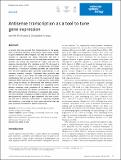Antisense transcription as a tool to tune gene expression
Author(s)
Brophy, Jennifer Ann; Voigt, Christopher A.
DownloadBrophy-2016-Antisense transcript.pdf (1.146Mb)
PUBLISHER_CC
Publisher with Creative Commons License
Creative Commons Attribution
Terms of use
Metadata
Show full item recordAbstract
A surprise that has emerged from transcriptomics is the prevalence of genomic antisense transcription, which occurs counter to gene orientation. While frequent, the roles of antisense transcription in regulation are poorly understood. We built a synthetic system in Escherichia coli to study how antisense transcription can change the expression of a gene and tune the response characteristics of a regulatory circuit. We developed a new genetic part that consists of a unidirectional terminator followed by a constitutive antisense promoter and demonstrate that this part represses gene expression proportionally to the antisense promoter strength. Chip‐based oligo synthesis was applied to build a large library of 5,668 terminator–promoter combinations that was used to control the expression of three repressors (PhlF, SrpR, and TarA) in a simple genetic circuit (NOT gate). Using the library, we demonstrate that antisense promoters can be used to tune the threshold of a regulatory circuit without impacting other properties of its response function. Finally, we determined the relative contributions of antisense RNA and transcriptional interference to repressing gene expression and introduce a biophysical model to capture the impact of RNA polymerase collisions on gene repression. This work quantifies the role of antisense transcription in regulatory networks and introduces a new mode to control gene expression that has been previously overlooked in genetic engineering.
Date issued
2016-01Department
Massachusetts Institute of Technology. Synthetic Biology Center; Massachusetts Institute of Technology. Department of Biological EngineeringJournal
Molecular Systems Biology
Publisher
Nature Publishing Group
Citation
Brophy, J. A., and C. A. Voigt. “Antisense Transcription as a Tool to Tune Gene Expression.” Molecular Systems Biology 12, no. 1 (January 14, 2016): 854–854.
Version: Final published version
ISSN
1744-4292